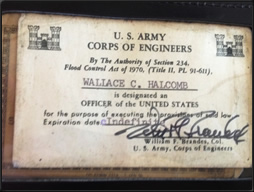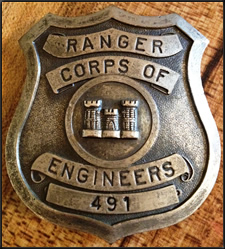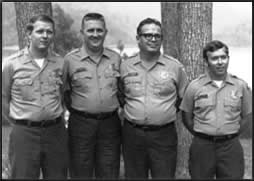|
1970
Flood Control Act, Section 234 � Senator Cooper of Kentucky initiates legislation establishing a Citation Authority program to address littering problems at a Corps project.
1971
36 Code of Federal Regulations, Chapter III, Part 327 establishes the first nationwide set of rules and regulations governing public use of Corps of Engineers Water Resources Development Projects
Pilot Citation Program: Lake Cumberland, Kentucky Six Park Rangers are granted authority to enforce rules by issuance of warning only.
The First Badge is originally bought from the US Marshall�s Service in Lexington Kentucky for $75.00 US. The badge is engraved by a local jeweler.
1972
Citation Program goes nationwide and citations can be issued.
Park Ranger Wallace Holcomb issues the first citation to a violator at Lake Cumberland. A number of warning citations are written by Dave Stidham and Anon Bozeman prior to Wallace�s citation.
Wallace issues the first citation to a resident of Burnside, KY, for an unpermitted dock on Lake Cumberland. Wallace�s first actual citation goes to court.
1973
Beginnings of diversity in the Park Ranger ranks are evident. Deborah Chenoweth, hired at Caesar Creek Lake, OH in January 1973, becomes the third female Corps of Engineers Park Ranger in the nation. Although the first two hires leave within a year, Chenoweth has a long and successful career progression with the Corps.
1974
Review of Visitor Protective Services - This Corps program review includes a look at the agency�s limited Park Ranger authority, and inability of local authorities to enforce. The study addresses options including increased authority, adding to Park Ranger staffing, assuming complete enforcement responsibility, letting state and local agencies assume those responsibilities, or keeping Corps authorities fundamentally the same and initiating Law Enforcement Contracts. Other recommended changes include improving regulations and guidance, training, and uniforms.
1977
An incident occurs at Thurmond Lake involving a Summer Park Ranger carrying a handgun on duty, outside the scope of his authority. During a hazing ritual that includes a local group of teenagers, some young men are reported as streaking in a Corps campground. The Summer Ranger attempts to fire a warning shot into the air, but accidently shoots and kills one of the teenage boys. The Corps is found to be partially liable, since the Summer Ranger�s supervisor was aware he was armed.
1977
Opal James and David Small, Park Rangers at Blue Mountain Lake, Arkansas, are ambushed and abducted by Paul Ruiz and Earl Van Denton, escapees from an Oklahoma State Prison. A local Marshall and Small are forced into a car trunk. The men hear the escapees say "You know what we've got to do", and shots are fired into the car trunk. The shots fatally injure the Marshall. Small, although critically injured, survives. James is held hostage for two days then eventually executed in Oden, Arkansas. The escapees continue their crime spree resulting in additional murders in Louisiana. They are later captured in Portland, Oregon. David Small testifies a number of times since Ruiz and Van Denton file multiple appeals, but the escapees are eventually executed in 1998.
1979
ER 1130-2-420-Program policy and guidance is established for Visitor Assistance training. This educates Park Rangers on how to conduct duties concerning the public in a safe manner.
1983
Sections 111 and 114, title 18: Park Managers and Park Rangers included among federal officers protected against assault.
1986
Uniform regulations established for Natural Resources Management Program and Staff.
1986
Nationwide USACE promotion of water safety begins through an annual, unified safety education campaign.
| |

Officer citation card for Wallace Halcomb

First Badge was originally purchased from the US Marshalls Service in Lexington, KY.

Second Badge that was issued to Park Rangers

Original group of Citation Pilot program at Lake Cumberland, left to right :Bozeman, Halcomb, Thomas, Patterson
|




